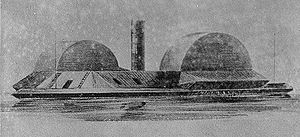CSS Nashville (1864)

| |
| Career | Confederate Navy Jack Confederate Naval Ensign after 1863 |
|---|---|
| Name: | CSS Nashville |
| Laid down: | September 1862 |
| Launched: | mid-1863 |
| Commissioned: | September 15, 1864 |
| Decommissioned: | May 10, 1865 |
| Fate: | Surrendered to U.S. forces; sold November 22, 1867 |
| General characteristics | |
| Displacement: | approximately 1100 tons |
| Length: | 271 ft (83 m) |
| Beam: | 62 ft 6 in (19.05 m) |
| Draft: | 10 ft 9 in (3.28 m) |
| Propulsion: | Steam engine |
| Speed: | unknown |
| Complement: | unknown |
| Armament: |
• 3 × 7 in (180 mm) Brooke rifles • 1 × 24-pounder howitzer |
CSS Nashville was a large side-wheel steam ironclad built by the Confederates at Montgomery, Alabama intended to exploit the availability of riverboat engines. Launched in mid-1863, Nashville was taken to Mobile, Alabama for completion in 1864. Part of her armor came from the CSS Baltic. Her first commander was Lieutenant Charles Carroll Simms, CSN.
Still fitting out, she took no part in the Battle of Mobile Bay on August 5, 1864. She helped fend off attacks on Spanish Fort, Alabama on 27 March 1865, supported Confederate commander Randall L. Gibson until driven away by Federal batteries, and shelled Federal troops near Fort Blakely on 2 April 1865. The ships retreated up the Tombigbee River on 12 April 1865 when Mobile surrendered. She was one of the vessels formally surrendered by Commodore Ebenezer Farrand, CSN, at Nanna Hubba, Alabama on May 10, 1865.
Although never quite finished, she had been heavily armored with triple 2-inch plating forward and around her pilot house, only a single thickness aft and there had been some doubts expressed that her builders might have overestimated her structural strength. Rear Admiral Henry K. Thatcher, USN, wrote on June 30, 1865, after survey, "She was hogged when surrendered and is not strong enough to bear the weight of her full armor." He was certain "she could not live in a seaway."
Nashville was purchased by the Navy Department and sold to breakers at New Orleans, Louisiana on November 22, 1867, her iron sheathing having been removed for naval use.
Commanders
- Lieutenant Charles Carroll Simms (1864)
- Lieutenant John W. Bennett (late 1864 - May 1865)
- Nashville plan drawing.jpg
Rebel Ram CSS Nashville
- Sketch Ram Nashville.jpg
Sketch Ram CSS Nashville
References
- This article includes text from the public domain Dictionary of American Naval Fighting Ships. The entry can be found here.
| ||||||||
| File:Unionbar.svg File:Dixiebar.svg | This article about the American Civil War is a stub. You can help Ship Spotting World by expanding it. |
| 40px | This article about a specific naval ship or boat is a stub. You can help Ship Spotting World by expanding it. |
